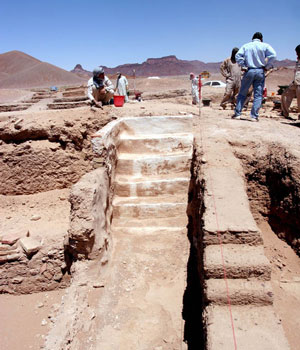
A view of the archeological excavations that show the old staircase
Al Ala, Saudi Arabia- Walking amongst the ruins of this Islamic city, the essence of history fills the air. Unearthed by a team of experts from King Saud University, the ruins are part of an Islamic city from the 8th century (2nd century Hijri) known as Al Mabiyat and renowned for industry.
The archeological excavations revealed a wall, measuring 800m x 800m, and a city buried under 7 meters of earth. According to Dr. Mashlih Al Marikhi, professor at the Faculty of Archeology and Tourism said the wall “was built at a later date in the history of the city as it does not follow a straight path. Perhaps the city’s inhabitants decided to build it in the 12th century (6th century Hijri), in order to protect their homes during war and political upheaval.”
Inside the city, the archeological excavations have uncovered a beautifully designed house, according to the standards that were popular at the time with the flooring decorated with colored tiles. It also holds a staircase to the second floor, the remains of an old bathroom and a kitchen next to columns. “The house probably belonged to a city noble or a member of the local government, given the elaborate designs and decorations.”
Outside the city wall, archeologists discovered ovens to produce tiles, pottery and ceramics.
“The city was a main station on the Hajj route. It was renowned for being unique, as it combined different cultures, most importantly Egyptian, Iraqi and Syrian. This gave it a special cultural character.”
“Its birth pre-dates Islam but it prospered and flourished between 800 and 1100A.D (2nd and 5th centuries Hijri). It declined towards the end of the Abbasid caliphate, after the inhabitants of Syria stopped embarking on Hajj because of the Crusades. The city’s economy suffered.”
In the surrounding hills, archeologists discovered pottery, glass and ceramic pieces, prompting Dr. Mashlih to describe the city as “an open air museum. It used to be an advanced industrial city, similar to Al Khobar today.”
“What we have discovered from ancient relics demonstrates the advanced techniques and designs the inhabitants had achieved. Their glass and urban designs were exceptional and renowned.”
When Asharq Al Awsat visited the site, it found several workers, archeology students and teachers working together in the name of humanity and scientific research. One student named Rida said, “We want to prove that, as Muslims, our history is not inferior to Greek, Roman or Pharaonic history.”
However, the university will require an estimated 25 years or more to complete the excavations and bring back to life the history of a once-forgotten city.
“This is the third year that we have excavated this site. Every academic year, students spend two months digging, as part of their practical experience. What we have excavated so far is only a small part of Al Mabiyat. The University is also restoring and protecting the sites that archeologists uncover because we believe it is important to preserve our history.”

A view of the discovered historical city of Al-Mabiyat
